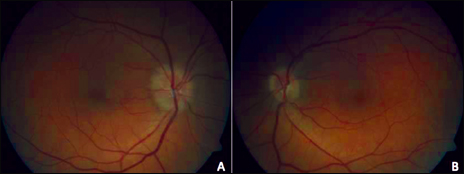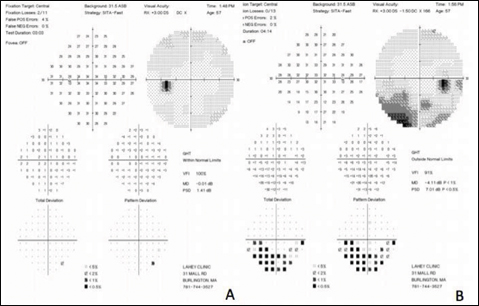Woman referred for acute flashing lights and visual distortion
Fundus exam revealed mildly blurred disc margins in the right eye and a crowded disc in the left eye.
A 47-year-old Caucasian woman with no significant medical or ocular history was referred to the Lahey Eye Clinic with complaints of flashes of light in the periphery of her right eye. Three weeks before presentation, she noted the flashes only at night but denied any floaters, curtain or veil in her vision or acute loss of vision. She originally went to see an outside optometrist who noted possible “swelling of the right nerve.” She was told to come back in a few days for re-evaluation. At the second appointment, the swelling was more significant, thus the patient was sent to Lahey for further evaluation.
The morning of her visit, she also noted a new onset “film” in front of her right eye, which resolved after a few hours. She described a constant “water-like” distortion that was present temporally in her right eye. Of note, the patient mentioned that she had developed a bad viral infection 1 month before presentation. This reportedly triggered a herpetic flair with genital and oral ulcers. At that time, she also noted stomach pain, lethargy and decreased weight. She denied any lesions near or involving the eyes or nose. Review of systems was negative except for what was noted above.
Examination

Images: Dajani OAW, Athappilly G


Upon examination, visual acuity was 20/30 in the right eye and 20/20 in the left. Pupils were equal, round and reactive with no relative afferent pupillary defect. IOP was 14 mm Hg in the right eye and 15 mm Hg in the left. Confrontational visual fields revealed inferior field loss in the right eye, but they were full in the left. Bilateral extraocular movements were full. Color vision testing was full in each eye. Anterior segment exam was significant for pigmented cells bilaterally after dilation. Fundus exam revealed mildly blurred disc margins in the right eye and a crowded disc in the left (Figure 1). OCT of the nerve verified optic nerve edema in the right eye (Figure 2), and visual field testing demonstrated the inferior field loss (Figure 3).
What is your diagnosis?
See answer on the next page.
Unilateral disc edema
Our patient was found to have unilateral disc edema on presentation with slightly decreased vision in her right eye. Differential diagnosis of unilateral disc edema with decreased vision includes infiltrative processes of the optic nerve and optic neuritis due to demyelinating disease, as well as a number of infectious and inflammatory processes. In an older age patient, nonarteritic ischemic optic neuropathy and temporal arteritis would be in the differential. An MRI of the brain and orbits was ordered to evaluate the retrobulbar optic nerve and to check for any intracranial lesions. The MRI of the brain and orbits was unrevealing for optic nerve or intracranial pathology, making demyelinating disease less likely. In addition to imaging, labs were drawn to check for inflammatory and infectious processes and specifically syphilis, sarcoidosis, Lyme disease and herpes simplex. All labs were negative except for Treponema pallidum antibody, which was reactive, as well as RPR titer. Based on the lab results and symptoms, the patient was diagnosed with ocular syphilis. Subsequent HIV testing was negative.
Discussion
Acquired syphilis is traditionally divided into primary, secondary, latent and tertiary syphilis. Initially, syphilis presents as a painless chancre, which normally resolves within weeks. Secondary syphilis often presents as a diffuse, maculopapular rash that may also be associated with fever, sore throat, joint pain and other systemic symptoms. Tertiary syphilis most commonly leads to cardiovascular and neurologic complications, with patients often developing meningitis. Ocular syphilis can occur in either the secondary or tertiary stage but either way most commonly presents as uveitis. It can affect many structures in the eye, with initial symptoms ranging from interstitial keratitis, scleritis and acute iritis to retinal vasculitis, disc edema and optic atrophy.
Diagnosis of ocular syphilis is based on clinical signs as well as laboratory testing. If any concerns exist based on history, such as the symptoms above or a history of rash, sexually transmitted infections or any other behavior considered “risky,” serologic testing should be ordered, including both non-treponemal and treponemal tests. Non-treponemal tests such as RPR and VDRL are the most useful for tracking active disease as well as treatment efficacy. Treponemal tests, including FTA-ABS, measure antibodies against T. pallidum proteins. The CDC recommends ordering an RPR initially, which if positive confirms syphilis. If negative, it suggests ordering a treponemal test (FTA-ABS), which if positive then provides the diagnosis. HIV testing is also indicated in any patient with a diagnosis of syphilis due to the risk of coinfection.
The major question in a setting of ocular syphilis is whether or not it constitutes neurosyphilis. While many experts agree that retinal or nerve involvement indicates neurosyphilis, there is often disagreement in regard to syphilis affecting only the anterior segment. This question is crucial because it often leads to debate regarding the need for lumbar puncture in patients with only ocular symptoms and a diagnosis of syphilis. The current management guidelines recommend a lumbar puncture to assess for cerebrospinal fluid (CSF) involvement in any patient with positive serology and neurologic or ophthalmic signs, including papillitis and anterior/posterior uveitis.
Regarding treatment, ocular syphilis of the posterior segment should be managed the same way as neurosyphilis with a 10- to 14-day course of high-dose IV penicillin. Follow-up should include a repeat lumbar puncture every 6 months for 2 years. In addition, consultation with infectious disease is recommended during follow-up to help determine successful management as well as the potential for future antibiotics.
Clinical course continued
The patient was admitted to the hospital for a lumbar puncture and initiation of IV penicillin therapy. The lumbar puncture was negative for CSF VDRL, and she was sent home to complete a 14-day course of 4 million units of IV penicillin G every 4 hours. One week after initiation of penicillin, the patient presented with vision of 20/50 in the right eye, greater color desaturation and an afferent pupillary defect. She also had a newly noted mild vitritis. Repeat MRI was negative, but there was concern that this could possibly be a Jarisch-Herxheimer reaction vs. inevitable course of the disease. As the patient had received IV antibiotics, it was felt by infectious disease that it was safe to have a short course of oral prednisone. Over the course of the next month, her vision improved slightly to 20/40 in the right eye, the vitritis resolved, and the inferior nasal defect improved. The optic nerve edema was also no longer present. The left eye continued to be unaffected. Over the course of the next few months, she is to be followed by infectious disease as well as ophthalmology, with plans for continued intervention if further symptoms develop.
- References:
- Aldave AJ, et al. Curr Opin Ophthalmol. 2001;12(6):433-441.
- Amaratunge BC, et al. Clin Experiment Ophthalmol. 2010;doi:10.1111/j.1442-9071.2010.02203.x.
- Chao JR, et al. Ophthalmology. 2006;doi:10.1016/j.ophtha.2006.05.048.
- Davis JL. Curr Opin Ophthalmol. 2014;doi:10.1097/ICU.0000000000000099.
- Gaudio PA. Curr Opin Ophthalmol. 2006;doi:10.1097/ICU.0b013e328010a9b5.
- Kiss S, et al. Semin Ophthalmol. 2005;doi:10.1080/08820530500232092.
- For more information:
- Omar A.W. Dajani, MD, and Geetha Athappilly, MD, can be reached at New England Eye Center, Tufts University School of Medicine, 750 Washington St., Box 450, Boston, MA 02111; website: www.neec.com.
- Edited by Jessica Moon, MD, and Emily C. Wright, MD. They can be reached at the New England Eye Center, Tufts University School of Medicine, 750 Washington St., Box 450, Boston, MA 02111; website: www.neec.com.
